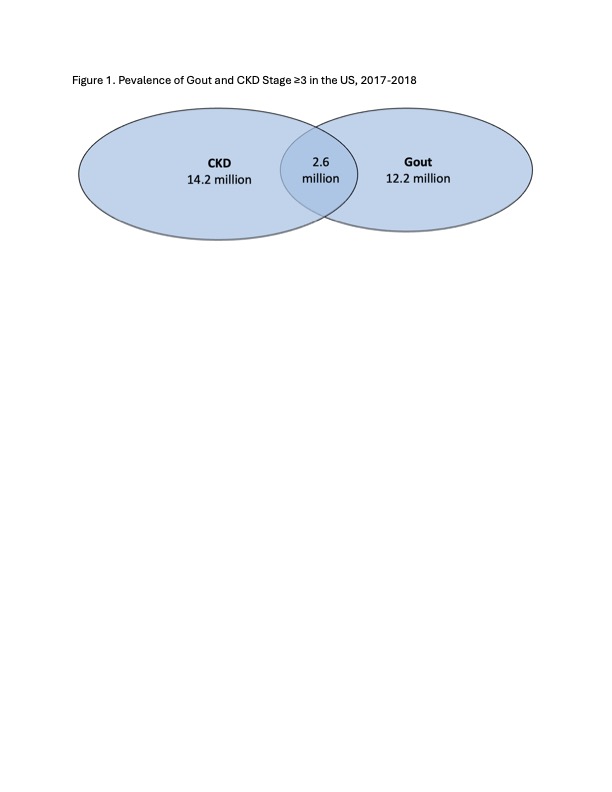Session Information
Date: Sunday, November 17, 2024
Title: Metabolic & Crystal Arthropathies – Basic & Clinical Science Poster II
Session Type: Poster Session B
Session Time: 10:30AM-12:30PM
Background/Purpose: Gout and chronic kidney disease (CKD) are both common conditions which are associated with high morbidity and mortality and often coexist. We sought to determine the contemporary prevalence and population size of comorbid gout and chronic kidney disease and their independent associations using the latest US general population data.
Methods: We used data from the National Health and Nutrition Examination Survey (NHANES) 2017-18 in which self-reported data on history of gout were ascertained. We calculated the estimated glomerular filtration rate (eGFR) based on the laboratory data collected as part of NHANES using the CKD-EPI creatinine equation. We examined the prevalence of CKD stage 3 or greater, defined as eGFR < 60 mL/min/1.73 m2. Covariates included age, sex, race/ethnicity, body mass index, hypertension, and type 2 diabetes. All statistical analyses were performed using survey commands of SAS to adjust for clusters and strata of the complex sample design and to incorporate sample weights to generate estimates for the total civilian, noninstitutionalized US population. We examined the characteristics of the US population by history of CKD. We calculated the national prevalence and population estimates of gout and CKD according to age and sex in NHANES 2017-18. We conducted logistic regression analyses to calculate the odds ratio (OR) for CKD while adjusting for covariates.
Results: Individuals with CKD tended to be older than those without CKD and have higher prevalence of hypertension and type 2 diabetes, though body mass index was similar (Table 1). Between 2017-18, gout affected 5.1% (12.2 million) US adults, with higher prevalence among males and with increasing age (Table 2, Figure 1). During the same period, CKD affected 6.0% (14.2 million) individuals; like gout, CKD prevalence increased with age but was slightly more prevalent among females than males (Table 2, Figure 1). An estimated 2.6 million US adults during this period had both gout and CKD (Figure 1). Individuals with gout had 2.7-fold higher odds of having CKD compared to those without gout in the age/sex-adjusted model (OR 2.7, 95% CI,1.6 to 4.6); this association attenuated slightly but remained significant in the fully adjusted model (OR 2.4, 95% CI, 1.2 to 4.6).
Conclusion: Both gout and CKD are prevalent conditions among US adults, affecting 5.0% and 6.0%, respectively, of the general population in 2017-18. Furthermore, there were an estimated 2.6 million US adults who suffered from both gout and CKD during this period. These individuals stand to benefit greatly from treatment approaches with dual benefits (e.g., sodium-glucose cotransporter type 2 inhibitors) to simultaneously reduce the risk of recurrent gout and CKD progression.
To cite this abstract in AMA style:
Yokose C, Lu L, Rai S, McCormick N, Choi H. The Contemporary Prevalence of Comorbid Gout and Chronic Kidney Disease, Two Common Conditions with High Morbidity, in the US General Population [abstract]. Arthritis Rheumatol. 2024; 76 (suppl 9). https://acrabstracts.org/abstract/the-contemporary-prevalence-of-comorbid-gout-and-chronic-kidney-disease-two-common-conditions-with-high-morbidity-in-the-us-general-population/. Accessed .« Back to ACR Convergence 2024
ACR Meeting Abstracts - https://acrabstracts.org/abstract/the-contemporary-prevalence-of-comorbid-gout-and-chronic-kidney-disease-two-common-conditions-with-high-morbidity-in-the-us-general-population/



